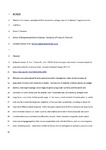Motion in the ocean – paradigm shift in movement ecology requires “sedentary” organisms to be redefined
| dc.contributor.author | Sheehan, Emma | |
| dc.date.accessioned | 2019-05-01T13:42:17Z | |
| dc.date.issued | 2019-06 | |
| dc.identifier.issn | 0021-8790 | |
| dc.identifier.issn | 1365-2656 | |
| dc.identifier.uri | http://hdl.handle.net/10026.1/13759 | |
| dc.description.abstract |
<jats:title>Abstract</jats:title><jats:p> <jats:mixed-citation publication-type="journal"><jats:bold>In Focus:</jats:bold> <jats:string-name><jats:surname>Hamel</jats:surname>, <jats:given-names>J.‐F.</jats:given-names></jats:string-name>, <jats:string-name><jats:surname>Sun</jats:surname>, <jats:given-names>J.</jats:given-names></jats:string-name>, <jats:string-name><jats:surname>Gianasi</jats:surname>, <jats:given-names>B. L.</jats:given-names></jats:string-name>, et al. (<jats:year>2019</jats:year>). . <jats:source>Journal of Animal Ecology</jats:source>. <jats:ext-link xmlns:xlink="http://www.w3.org/1999/xlink" xlink:href="https://doi.org/10.1111/1365-2656.12943">https://doi.org/10.1111/1365-2656.12943</jats:ext-link></jats:mixed-citation> </jats:p><jats:p>Effective ecosystem‐based fisheries and conservation management relies on the accuracy of population structure and connectivity models. The majority of sedentary marine species are pelago‐benthic, meaning the pelagic larval stages disperse using ocean currents, and the adults are stationary or crawl slowly over the seabed. Adult movement was, until recently, thought to be insignificant due to the limited spatial range. In this issue, a novel method of translocation for adults that may far exceed the dispersion capability of the juveniles is presented, providing evidence for important effects of adult dispersal. Active buoyancy adjustment (<jats:styled-content style="fixed-case">ABA</jats:styled-content>) is a behavioural response to environmental stressors or water currents that enables echinoderm Asteroidea (sea stars) and Holothuroidea (sea cucumbers) to efficiently relocate. Adult relocation using tides could explain mass spawning aggregations that increase population and individual fitness, and less advantageous mass stranding events. Implications of <jats:styled-content style="fixed-case">ABA</jats:styled-content> for future marine management and policy are discussed.</jats:p> | |
| dc.format.extent | 816-819 | |
| dc.format.medium | ||
| dc.language | en | |
| dc.language.iso | en | |
| dc.publisher | Wiley | |
| dc.rights | Attribution-NonCommercial-ShareAlike 4.0 International | |
| dc.rights | Attribution-NonCommercial-ShareAlike 4.0 International | |
| dc.rights | Attribution-NonCommercial-ShareAlike 4.0 International | |
| dc.rights | Attribution-NonCommercial-ShareAlike 4.0 International | |
| dc.rights | Attribution-NonCommercial-ShareAlike 4.0 International | |
| dc.rights | Attribution-NonCommercial-ShareAlike 4.0 International | |
| dc.rights.uri | http://creativecommons.org/licenses/by-nc-sa/4.0/ | |
| dc.rights.uri | http://creativecommons.org/licenses/by-nc-sa/4.0/ | |
| dc.rights.uri | http://creativecommons.org/licenses/by-nc-sa/4.0/ | |
| dc.rights.uri | http://creativecommons.org/licenses/by-nc-sa/4.0/ | |
| dc.rights.uri | http://creativecommons.org/licenses/by-nc-sa/4.0/ | |
| dc.rights.uri | http://creativecommons.org/licenses/by-nc-sa/4.0/ | |
| dc.subject | connectivity | |
| dc.subject | dispersal | |
| dc.subject | echinoderm | |
| dc.subject | marine protected area | |
| dc.subject | mass stranding | |
| dc.subject | movement ecology | |
| dc.subject | spawning aggregation | |
| dc.title | Motion in the ocean – paradigm shift in movement ecology requires “sedentary” organisms to be redefined | |
| dc.type | journal-article | |
| dc.type | Journal Article | |
| plymouth.author-url | https://www.webofscience.com/api/gateway?GWVersion=2&SrcApp=PARTNER_APP&SrcAuth=LinksAMR&KeyUT=WOS:000472660900001&DestLinkType=FullRecord&DestApp=ALL_WOS&UsrCustomerID=11bb513d99f797142bcfeffcc58ea008 | |
| plymouth.issue | 6 | |
| plymouth.volume | 88 | |
| plymouth.publication-status | Published | |
| plymouth.journal | Journal of Animal Ecology | |
| dc.identifier.doi | 10.1111/1365-2656.13006 | |
| plymouth.organisational-group | /Plymouth | |
| plymouth.organisational-group | /Plymouth/Faculty of Science and Engineering | |
| plymouth.organisational-group | /Plymouth/Faculty of Science and Engineering/School of Biological and Marine Sciences | |
| plymouth.organisational-group | /Plymouth/PRIMaRE Publications | |
| plymouth.organisational-group | /Plymouth/REF 2021 Researchers by UoA | |
| plymouth.organisational-group | /Plymouth/REF 2021 Researchers by UoA/UoA07 Earth Systems and Environmental Sciences | |
| plymouth.organisational-group | /Plymouth/Users by role | |
| plymouth.organisational-group | /Plymouth/Users by role/Academics | |
| dc.publisher.place | England | |
| dcterms.dateAccepted | 2019-04-08 | |
| dc.rights.embargodate | 2020-6-5 | |
| dc.identifier.eissn | 1365-2656 | |
| dc.rights.embargoperiod | Not known | |
| rioxxterms.versionofrecord | 10.1111/1365-2656.13006 | |
| rioxxterms.licenseref.uri | http://creativecommons.org/licenses/by-nc-sa/4.0/ | |
| rioxxterms.licenseref.startdate | 2019-06 | |
| rioxxterms.type | Journal Article/Review |



